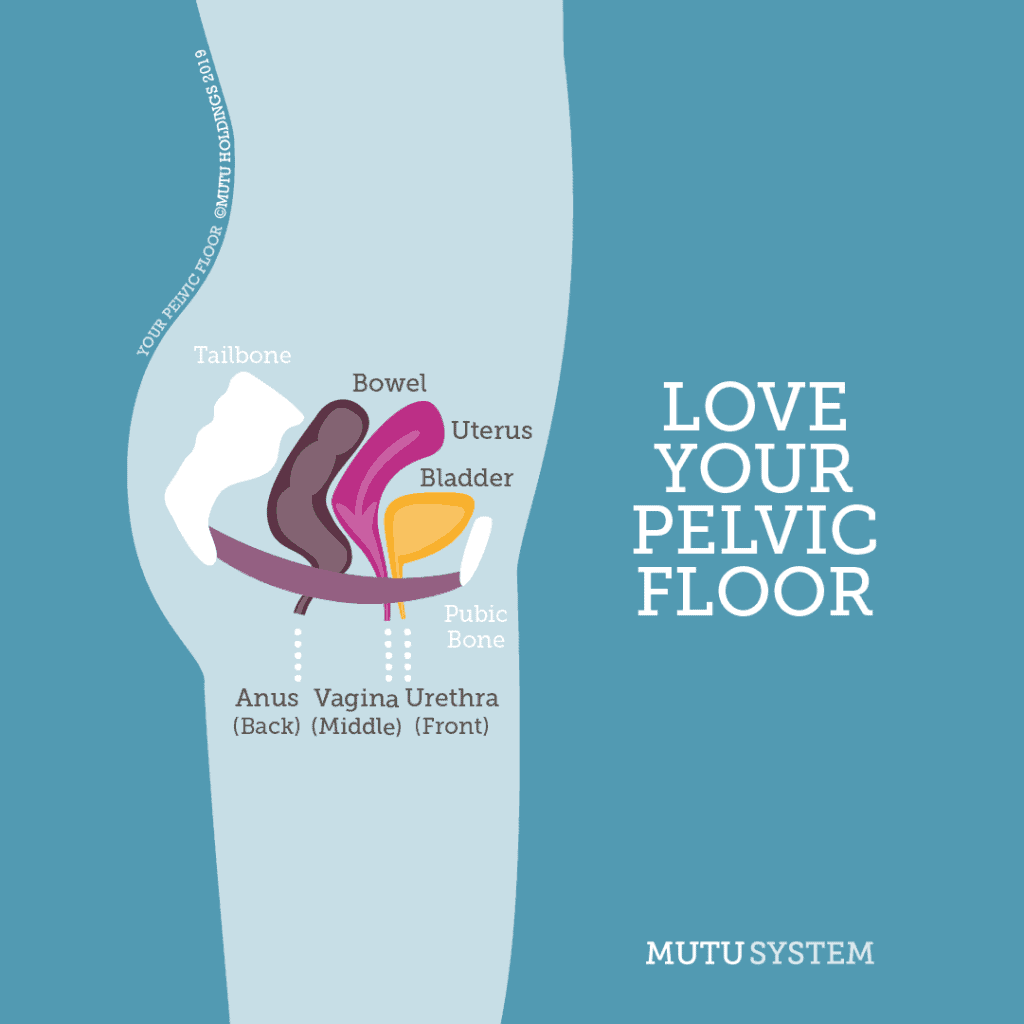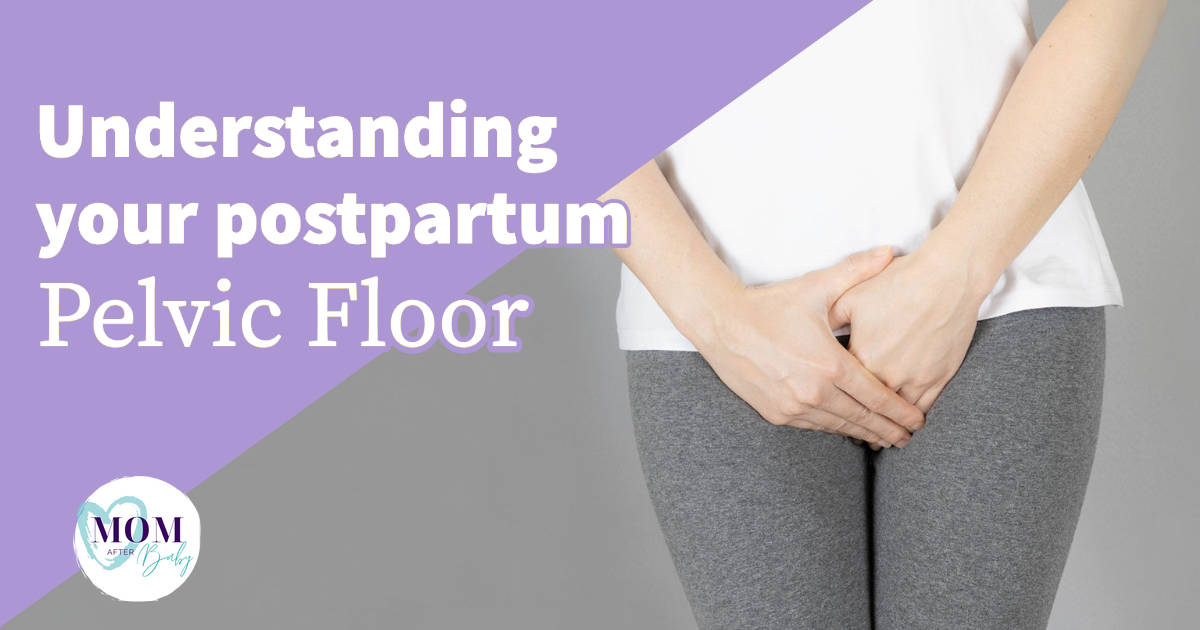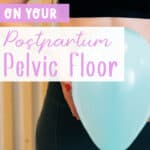Understanding your postpartum pelvic floor
This post may contain affiliate links that I may receive a commission from if you click & buy. In addition, the information on this site is NOT intended to be medical advice. See my full policy for more information.
You recently gave birth and have been experiencing some STRANGE things like never before…you’re leaking pee when you sneeze, and your back has a dull ache that won’t go away. You learn this is probably related to a weakened pelvic floor where you’re left wondering —WTF is a pelvic floor?!
Don’t worry moms, this article will help you understand your postpartum pelvic floor and why you should be paying attention to it!
If you didn’t already know, “Pelvic-perineal dysfunctions, are some of the most common problems experienced in women after pregnancy” according to a study done by the Journal of Prenatal Medicine.
Tell me if this sounds familiar:
- Leaking urine while you jump, sneeze, walk, or at random times.
- Painful Intercourse
- Painful urination
- Constant painful low back
- Pain in the pelvic region
- Heavy pressure by your rectum or pelvic region
- Distended abdomen with pressure
If any of those things listed above sound familiar, you could benefit from learning a little bit more about your pelvic floor health. So let’s jump in!
Understand Your Postpartum Pelvic Floor: What’s a Pelvic Floor?
The pelvic floor is a group of muscles and tissue that support the organs in your pelvic floor. Fun fact: BOTH men and women have a pelvic floor.
A helpful way to visualize this is by pretending your pelvic floor is a hammock with tons of beach balls stacked on top. The hammock is your pelvic floor, the beach balls are your organs!
These muscles are located just above or ‘around’ your vagina & rectum in which they connect from front to back and on each side.

How does pregnancy affect your pelvic floor?
How does pregnancy affect your pelvic floor?
Visualize your pelvic floor with all those organs stacked on top of it (see visual above). Now imagine a bigger, heavier weight growing and pushing those organs up against your pelvic floor. Just constant pressure, constant pushing.
Can you imagine what is happening to those muscles and connective tissue with all that pressure on top of them? They begin to slowly stretch out to accommodate your growing baby. Just like a rubber band, for example.
Not to mention, all those wacky pregnancy hormones causing EVERYTHING to ‘loosen’ up for your baby’s arrival.
Once your baby is born, that poor stretched-out muscle doesn’t just pop back into place. It takes time & it takes rehabilitation to tighten things up again.
Is pregnancy the only cause of pelvic floor dysfunction?
Contrary to what most think since most pelvic floor information is tailored to pregnant and postpartum moms, your pelvic floor can become weak or tense, leading to dysfunction from things outside of pregnancy. Some of that include:
- Obesity
- Menopause
- Traumatic Injuries
- Genetically Predisposed
- Pelvic Surgery or Procedures
- Excessive straining while using the bathroom
So, as you can see, pregnancy is not the only reason individuals experience pelvic floor dysfunction. For the sake of this article, we will be focusing on pelvic floor issues brought on by pregnancy.
Common Pelvic Floor Issues Postpartum
Earlier in this article, we listed out some of the common issues moms will experience when dealing with a weakened pelvic floor. So, we’re going to break these down a little further and discuss what you can do about it!
I also want to share this reminder: I am not a doctor or pelvic floor therapist. I’m a mom sharing my experience and knowledge on the topic. If you EVER experience signs of pelvic floor disorder — please seek out care from a healthcare provider or a pelvic floor therapist.
Pelvic Floor Pain After Birth
In those early weeks postpartum, your body will be feeling all sorts of different things as you recover from birth. However, pelvic floor pain has somewhat of a unique feel.
When I asked some of the moms in my community who experience pelvic floor pain what it felt like, they shared that:
“For me, it felt like my insides were being poked by a needle. It was a very sharp pain that would worsen if I sat down and got really bad whenever I had to use the bathroom.”
Another mom said, “the pain was so bad I thought my insides were infected or something, it was a constant pain that just would not go away”.
Why does it happen? Hormones, tearing, prolonged pelvic floor pressure or trauma, an episiotomy during labor, and more.
Just know, pain can have significant differences in sensation from one person to another, but if you’re feeling any discomfort at all as mentioned above, it’s likely your pelvic floor needs a little TLC.
Painful Intercourse Postpartum
According to one 2018 study, around 40% of women experienced painful intercourse who was 6 months postpartum.
Unfortunately, many women get dismissed when bringing up this concern. Assuming it’s just “normal” to experience painful intercourse because, hello, they just gave birth why wouldn’t it be painful?
Another common response a new mom is told is that she just needs lubrication.
Now, that may be true. Maybe you do need help lubricating yourself due to some underlying issues with your pelvic floor muscles, but lube alone is not the answer.
Postpartum Prolapse Recovery
Another condition some moms may experience after giving birth is pelvic organ prolapse (POP). This is when one of your pelvic organs is not being supported by the pelvic floor and has dropped into the vagina.
Often times moms will experience the feeling of something ‘bulging out’ or intense pelvic pressure.
Leaking Urine Postpartum(Postpartum Urinary Incontinence & Fecal Incontinence)
After you give birth, between the stretching your body did to get the baby out and the hormones surging through your body, it can leave the muscles responsible for controlling your bladder a little weak and worn down in the postpartum period. This leads to the dreaded urine leakage we all talk about and think is our ‘normal’ for the rest of life.
I know you might be wondering, will women who have a vaginal delivery have a higher chance of having pelvic floor issues like urinary incontinence than moms who have a c-section? The answer is yes, according to some studies.
Now it does not mean moms who have a cesarean birth won’t ever experience weak pelvic muscles, because they definitely can! However, it does present more often in moms who have had a vaginal delivery.
Struggling to live life without peeing on yourself? Try AZO’s Bladder Control for quick relief in just 2 weeks! Helps kick the annoying urgency to go and minimize the “oops, I think I peed myself” moments.*, NOTE: this is not intended for pregnant or nursing mothers.
How can I strengthen my pelvic floor?
Now that you understand a little bit more about this important muscle, it’s also just as important to understand how to help rehabilitate it so that it can be strong again! No more perineal pain, vaginal bulge, sexual function issues, or low back pain!

The BEST WAY to Fix Pelvic Floor Problems: Pelvic Floor Physical Therapy
Seeking help from a pelvic floor physical therapist is the BEST way to address and resolve your pelvic floor muscle dysfunctions.
You’ll have a thorough physical assessment where they assess your low back and pelvic region, breathing, abdominal contraction, and internal pelvic floor strength. To summarize, they’re looking at your muscle’s ability to contract, control and relax. In addition, checking for any kind of prolapse.
From there, they will go over your postnatal recovery plan along with practicing exercises and proper muscular engaging techniques in person to slowly build up your pelvic floor muscle strength.
Need help finding a pelvic floor therapist? Click here to find one near you!
The ALTERNATIVE WAY to Fix Pelvic Floor Problems: DIY Pelvic Floor Exercises
There’s a variety of exercises you can do at home or at a pelvic floor specialist’s office to regain the strength of your pelvic floor again (if strength is what you need). Some women have too much tension, so their pelvic floor therapy will be based on releasing some of that excess tension.
Below is a short list of pelvic floor exercises you can do AT-HOME:
- Kegels – These are a great way to practice contracting and relaxing your pelvic floor. The best way to think about performing these is if you’re trying to stop yourself from peeing. Feel the contraction “tight, up, & in”, then release. Practicing these multiple times throughout the day can make a big difference in strengthening your pelvic floor!
- Glute bridges – Glute bridges are an excellent way to engage your pelvic floor. You’ll want to lay flat on the floor with your feet bent at a 90-degree angle with your arms out to the side. Inhale, lift your hips up until you feel your pelvis ‘lock in place’ at the top (also known as a pelvic tilt). While lifting your hips, really focus on contracting your pelvic floor & glutes. Then bring your hips back down as you relax your muscles. The key to this movement isn’t moving the hips up and down, more so it is feeling and practicing those muscle contractions.
- Basic Core Activation (click for video) – Your core is very involved in supporting your pelvic floor, hence why it’s important to make sure you practice activating it properly after childbirth! Follow along the video to practice at home!
- Bird Dog Stretches – Get down on your hands and knees. Brace your core, and begin lifting your left arm & right leg together until you form a straight line between the two. Keep your head and spine neutral with the goal of not rocking your body around and keeping the core and pelvic floor tight. As you bring your arm & leg back down, alternate to the other sides doing the same thing. These are an excellent movement to engage your core, back, hips, glutes, and pelvic floor.
The BEST GADGET to Fix Pelvic Floor Problems: Kegel Trainer (or pelvic floor trainer)
A kegel exerciser is a small device that you can insert into your vagina and practice pelvic floor contractions.
These pelvic floor trainers work by connecting to an app via your phone. Then they prompt you to contract at different times and for different lengths at a time!
What’s neat about this tool is that it uses real-life biofeedback to track the quality of your pelvic floor contractions. Plus, this kegel trainer by Elvie says you only need 5 minutes a day, 3 times a week to notice pelvic health improvement!
The At-Home Remedy to Fix a Weak Pelvic Floor: Mutu System
When finding a pelvic floor therapist isn’t an option due to whatever reason and a kegel trainer is also off the list, try an at-home rehab program, like Mutu System!
Mutu System is a medically recommended, evidence-based home workout program for moms. Literally created to help them restore their core and pelvic floor health during pregnancy AND postpartum.
Why do so many moms like myself love it? Because it’s affordable and it works! In fact, you can take a look at some REAL RESULTS after using the Mutu System from mamas just like you!
Within the program, their expert trainers will walk you through proper movement, core & pelvic floor engagement, and more!
If you’d like to give it a try, you can sign up right here and try it for free! Your trial includes the following (list below from Mutu Website):
- FREE MUTU taster videos including core rehab and intensive exercises
- 10 days of support from your very own certified MUTU Pro
- Accountability and motivation in your private support group
- Daily challenges to help you make progress and feel results
- Live workouts and coaching with your challenge support manager!
- Daily motivation from the Mutu Team
- Text and email reminders
- Online support
To summarize, it’s normal to struggle with pelvic floor weakness and dysfunction after pregnancy and birth, but it doesn’t need to be your indefinite normal.
*These statements have not been evaluated by the Food and Drug Administration. This product is not intended to diagnose, treat, cure, or prevent any disease.
Read more postpartum articles here:
13 Practical Ways to Fix An Unhappy Marriage After Baby
Cool Moms Don’t Sleep: 10 Tips for Exhausted New Moms
Best Leakproof Underwear For Moms (that’s NOT a diaper)
How To Grocery Shop With A Newborn (because we all know it’s insanely nerve-wracking)
Postpartum Body Image Struggles: 15 Confidence Boosting Tips
Freezer Meals for Postpartum: A Must for New Moms
Incredible Benefits of Taking Collagen While Breastfeeding & Postpartum













Great blog post with very informative information.
Thank you